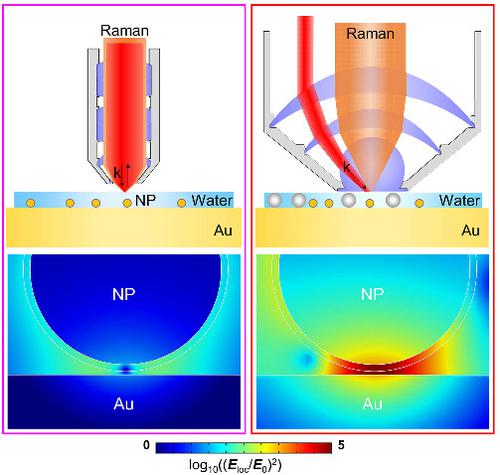当前位置:
X-MOL 学术
›
J. Raman Spectrosc.
›
论文详情
Our official English website, www.x-mol.net, welcomes your feedback! (Note: you will need to create a separate account there.)
Attenuated total reflection‐cascading nanostructure‐enhanced Raman spectroscopy on flat surfaces: A nano‐optical design
Journal of Raman Spectroscopy ( IF 2.5 ) Pub Date : 2020-10-15 , DOI: 10.1002/jrs.6006 En‐Ming You 1 , Hai‐Long Wang 1 , Jun‐Rong Zheng 1 , Zhao‐Dong Meng 1 , Mao‐Xin Zhang 1 , Song‐Yuan Ding 1 , Zhong‐Qun Tian 1
Journal of Raman Spectroscopy ( IF 2.5 ) Pub Date : 2020-10-15 , DOI: 10.1002/jrs.6006 En‐Ming You 1 , Hai‐Long Wang 1 , Jun‐Rong Zheng 1 , Zhao‐Dong Meng 1 , Mao‐Xin Zhang 1 , Song‐Yuan Ding 1 , Zhong‐Qun Tian 1
Affiliation

|
The surface‐enhanced Raman scattering (SERS) effect was discovered by Richard Van Duyne et al. in 1977. He and coworkers also first utilized an innovative strategy that used SERS to record spectra on such SERS‐inactive substrate surfaces as n‐gallium arsenide (100) surfaces, which were modified by silver nano‐islands. This nanostructure‐enhanced Raman spectroscopy on flat surfaces (NERSoFS) enabled such SERS applications to be expanded to a variety of materials by virtue of SERS‐active nanostructures such as Au or Ag nanoparticles and shell‐isolated nanoparticles. However, most of such systems, although yielding Raman spectra, produce rather low enhancements, especially when used to record spectra on flat surfaces of SERS‐inactive materials. In this work, along with the direction of Van Duyne's borrowing‐SERS strategy and on the basis of the strategy of cascading optical coupling, we consider a theoretically designed optical configuration, based on an attenuated total reflection‐cascading nanostructure to produce enhanced Raman spectroscopy (ATRc‐NERS) on flat surfaces. This system can effectively harvest the incident light, thereby boosting the local optical field of the incident light and also moderately increasing the radiation field of the Raman‐scattered signals. In this way, one can gain 1–2 additional orders of magnitude in Raman enhancement over present NERSoFS systems both on metallic and nonmetallic flat surfaces, which are otherwise SERS‐inactive. This ATRc‐NERS strategy can potentially be used to develop ultrasensitive and versatile tools for surface science, material science, catalysis, electrochemistry, and micro‐electronics and micro‐LED industries.
中文翻译:

平坦表面上的衰减全反射级联纳米结构增强拉曼光谱:纳米光学设计
理查德·范·迪恩(Richard Van Duyne)等人发现了表面增强拉曼散射(SERS)效应。1977年。他和同事们还首次采用了一种创新的策略,即使用SERS在非SERS惰性衬底表面上记录光谱,例如砷化镓n(100)表面,并通过银纳米岛对其进行了改性。这种在平面上增强纳米结构的拉曼光谱(NERSoFS)使得SERS的应用范围可以通过具有SERS活性的纳米结构(例如Au或Ag纳米颗粒和壳分离的纳米颗粒)扩展到多种材料。但是,大多数此类系统虽然会产生拉曼光谱,但产生的增强效果却很低,尤其是用于在SERS惰性材料的平坦表面上记录光谱时。在这项工作中,还有范·杜恩(Van Duyne)的指导 在借用SERS策略和级联光耦合策略的基础上,我们考虑了基于衰减全反射级联纳米结构以在平面上产生增强拉曼光谱(ATRc-NERS)的理论设计的光学配置。该系统可以有效地收集入射光,从而增强入射光的局部光场,并适度增加拉曼散射信号的辐射场。这样,与现有的NERSoFS系统相比,无论在金属还是非金属平面上,拉曼增强的拉曼增强能力都可以提高1-2个数量级。这种ATRc-NERS策略可以潜在地用于开发用于表面科学,材料科学,催化,电化学,
更新日期:2020-10-15
中文翻译:

平坦表面上的衰减全反射级联纳米结构增强拉曼光谱:纳米光学设计
理查德·范·迪恩(Richard Van Duyne)等人发现了表面增强拉曼散射(SERS)效应。1977年。他和同事们还首次采用了一种创新的策略,即使用SERS在非SERS惰性衬底表面上记录光谱,例如砷化镓n(100)表面,并通过银纳米岛对其进行了改性。这种在平面上增强纳米结构的拉曼光谱(NERSoFS)使得SERS的应用范围可以通过具有SERS活性的纳米结构(例如Au或Ag纳米颗粒和壳分离的纳米颗粒)扩展到多种材料。但是,大多数此类系统虽然会产生拉曼光谱,但产生的增强效果却很低,尤其是用于在SERS惰性材料的平坦表面上记录光谱时。在这项工作中,还有范·杜恩(Van Duyne)的指导 在借用SERS策略和级联光耦合策略的基础上,我们考虑了基于衰减全反射级联纳米结构以在平面上产生增强拉曼光谱(ATRc-NERS)的理论设计的光学配置。该系统可以有效地收集入射光,从而增强入射光的局部光场,并适度增加拉曼散射信号的辐射场。这样,与现有的NERSoFS系统相比,无论在金属还是非金属平面上,拉曼增强的拉曼增强能力都可以提高1-2个数量级。这种ATRc-NERS策略可以潜在地用于开发用于表面科学,材料科学,催化,电化学,



























 京公网安备 11010802027423号
京公网安备 11010802027423号